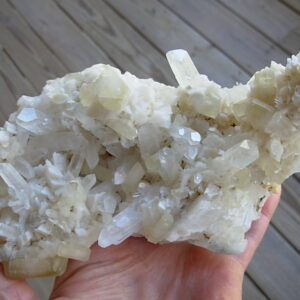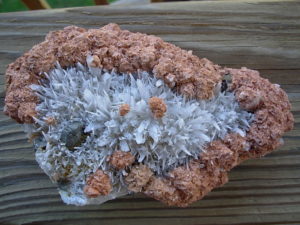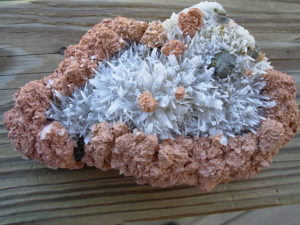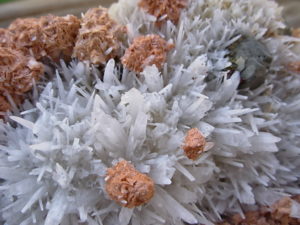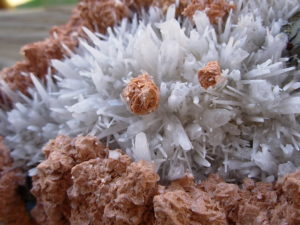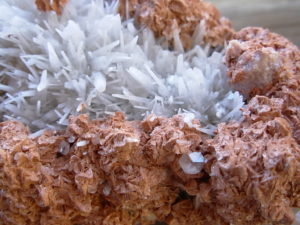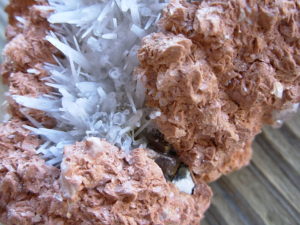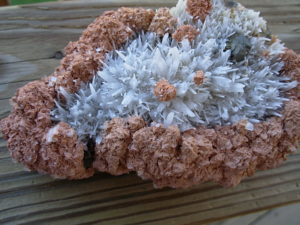Dolomite
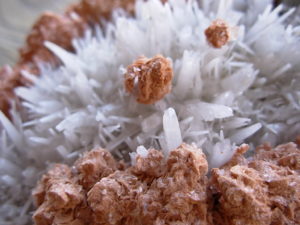 Dolomite is both a mineral and a rock. The mineral is a pure form sedimentary rock-forming mineral that can be found all over the world and is quite common in sedimentary rock formations. The rocks formed are a sedimentary carbonate structure composed mostly of Dolomite but also with impurities such as Calcite, Quartz, and Feldspar. The rock form is also called Dolomite, named for the French mineralogist, Deodat de Dolomieu who discovered Dolomite in 1791.
Dolomite is both a mineral and a rock. The mineral is a pure form sedimentary rock-forming mineral that can be found all over the world and is quite common in sedimentary rock formations. The rocks formed are a sedimentary carbonate structure composed mostly of Dolomite but also with impurities such as Calcite, Quartz, and Feldspar. The rock form is also called Dolomite, named for the French mineralogist, Deodat de Dolomieu who discovered Dolomite in 1791.
Dolomite has been responsible for a large scale debate on a topic referred to as the "Dolomite Problem". The problem?....Dolomite has been found all over the world in sedimentary dolomite beds that were formed in ancient rock structures. Dolomite does not form on the earth's surface anywhere in modern times. How can a rock so abundant no longer form? The answer is not easy...geologists who see sandstones, shales and limestones formed today almost before their eyes...but no Dolomite...believe that a process similar to metamorphism called dia-genesis occurs when mineralogical changes occur after the initial deposit is formed. They think that the calcite, aragonite and magnesium with a warm saline ground water may be the source of Dolomite formation. For more information on Dolomite http://en.wikipedia.org/wiki/Dolomite
An Interesting history and geology reference we found while researching Dolomite....There are dolomite
mountains in Italy...This information below courtesy of http://en.wikipedia.org/wiki/Dolomites
"The Dolomites are a mountain range located in north-eastern Italy that is a part of the Southern Limestone Alps. The name "Dolomites" is derived from the famous French mineralogist Déodat Gratet de Dolomieu who was the first to describe the rock, dolomite, a type of carbonate rock which is responsible for the characteristic shapes and colour of these mountains; previously they were called the "pale mountains," and it was only in the early 19th century that the name was Gallicized" (changed to Dolomites).
"During the First World War, the line between the Italian and Austro-Hungarian forces ran through the Dolomites. There are now open-air war museums at Cinque Torri (Five Towers) and Mount Lagazuoi. Many people visit the Dolomites to climb the vie ferrate, protected paths created during the First World War. A number of long distance footpaths run across the Dolomites, which are called "alte vie" (i.e., high paths). Such long trails, which are numbered from 1 to 8, require at least a week to be walked through and are served by numerous "Rifugi" (huts). The first and, perhaps, most renowned is the Alta Via 1."
Item # QPDOL11219997
Quartz and Pyrite on Dolomite from Kosovo, Yugoslavia
$165.00

This is an exciting and very rare specimen of quartz and Pyrite on Dolomite. We have never seen a specimen as unique as this one! It is from the Stari TRG Mine, Kosovo, Yugoslavia. This super piece also has minor Galena and Chalcopyrite. It is a very interesting display item that we are sure will be one of the first pieces noticed in any collection.
This piece weighs 33 oz or 2.06lbs (935g) and measures 6 x 3.5 x 2.2 inches (15.2 x 9 x 5.6cm)

